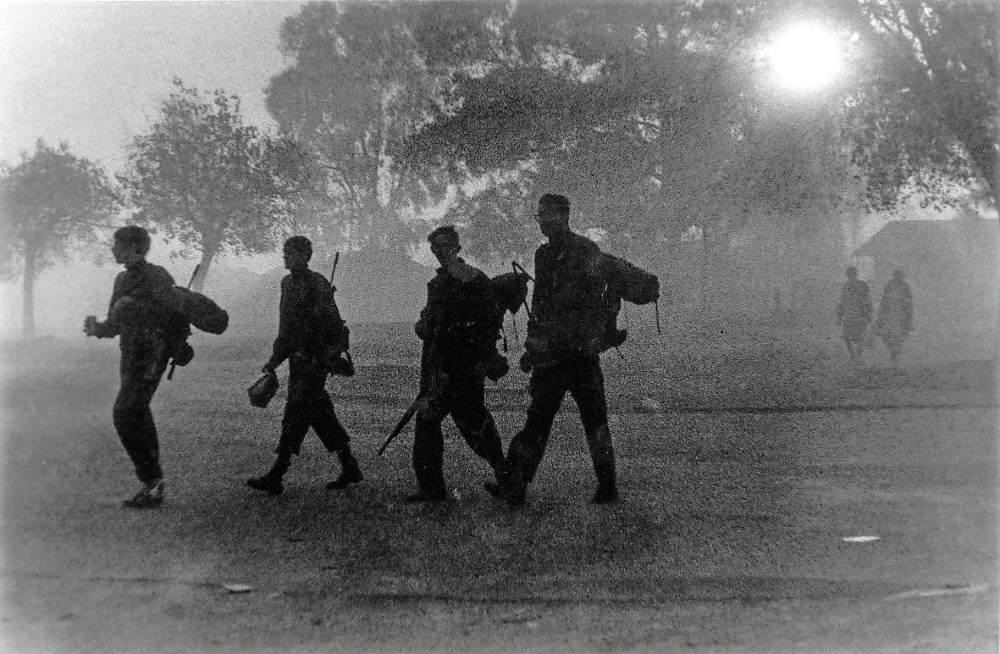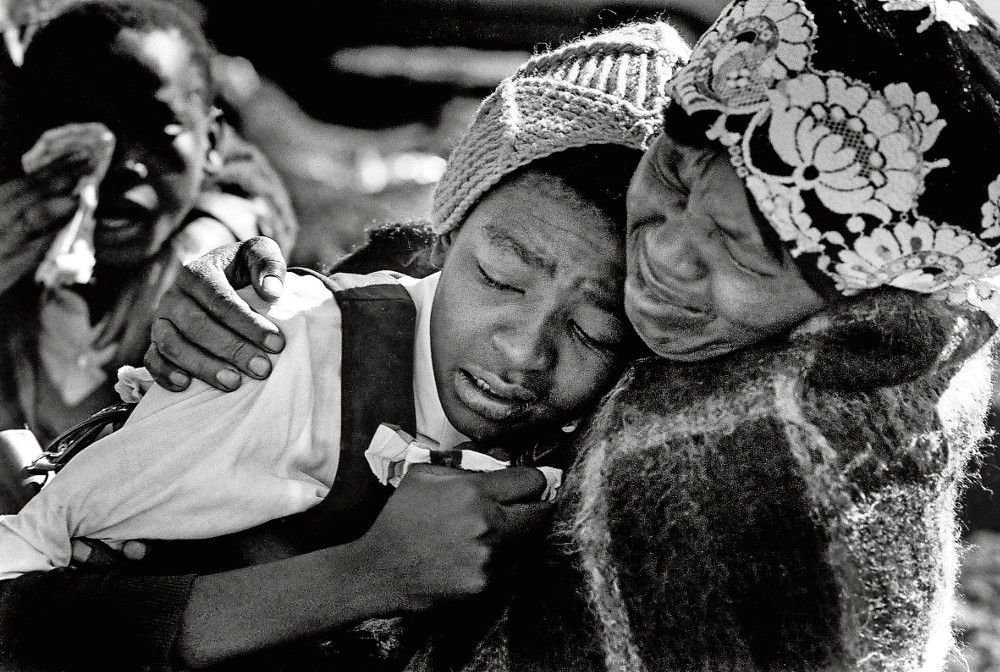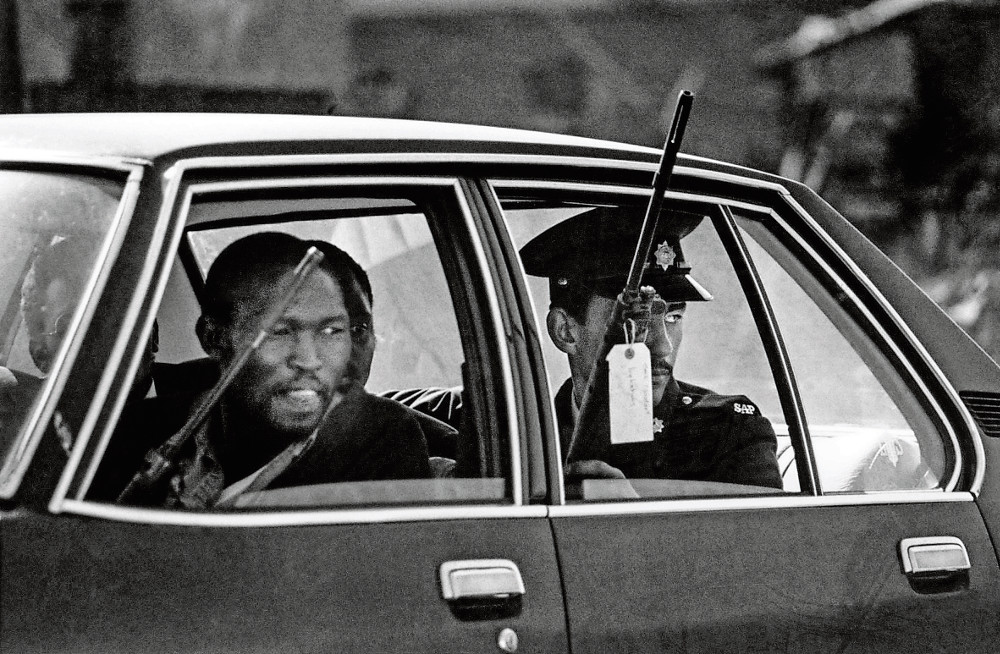A struggle without documentation is no struggle: Peter Magubane
JUNE 16 by Peter Magubane
(Serita sa Sechaba Publishers)
Peter Magubane awoke at dawn. The streets were still quiet as he made his way to the police station. The ominous shadows of heavily armed police officers walking through the cold, grey morning were the first photographs he took that day. It was June 16 1976.
Magubane’s book June 16 — the 23rd he has published — is not only an excellent collection of his photographs, it is also vitally important. It serves as an essential reminder of that day and those that followed as Magubane travelled all over South Africa, documenting the violence and subsequent trauma sparked by the Soweto student uprising.

(Credit: Peter Magubane)
It is also important to see all these images curated into one volume. It is never easy viewing, however — and nor should it be — for Magubane’s gaze is relentless. He never lets up, forcing us to confront our reality. His insatiable work ethic as well as his single-minded purpose comes through.
“It was tense, very tense,” recalls Magubane when we meet to talk about his book. “I saw this policeman chasing this youngster and I took a picture. He realised I had taken a picture. He came back and put the barrel of his gun on my forehead and said: ‘You do this again and I will kill you.’
“I said to myself: ‘If it happens, it happens; there is no way I can run away from it. This I must document.’ I was looking over my shoulder all the time.”
After shooting a roll of film, he would go to the nearest house and give it to someone to keep for him. “Those mothers helped me a great [deal], because after shooting I could go back at night to this house and that house and collect my pictures.
“I remember a group of boys running towards me. I lifted my camera. I could see they were not happy. I dropped my camera. I said to them: ‘A struggle without documentation is no struggle. You must let every person with a camera photograph what is going on. No matter if they are black or white. So that you have history, you have a record of what is going on.’ They let me photograph.
“The next day in Alexandra was real bad. A bullet went across my ear and cut open the stomach of a woman sitting there.
“People were dying like flies, man. I told myself no one is going to tell me to drop my camera, go home and sleep. I wanted to show the world how South Africa operates with its apartheid, to see what the hell was happening. I did what was right for me.”

(Credit: Peter Magubane)
He adds: “June 16 made what we had today possible. June 16 was pressure. It helped change the system in the country.”
It is easier getting my son to eat peas than it is to get Magubane to talk about himself. There is the usual attempt at distraction, changing the subject and eventual capitulation, followed by what looks like resentment.
I ask him what set him apart from other journalists. “I believed in getting the picture. I don’t believe in asking for permission to take a photograph. This is probably why I am where I am today. I made sure I bought Time magazine, Life magazine, Look magazine and saw what photographers were doing.
“I bought it to sharpen myself. I was very inquisitive. It paid off. I worked hard; I went there [into conflict situations] knowing full well I might get hurt, I might get arrested. It was not easy. I had to learn to hide my camera. I hid it in my jacket. I took a couple of pictures and hid it again.
“I cut a hole in a Bible to hide my camera. I cut a hole in a loaf of bread so I could take photographs without being seen. You have to be brave in everything.”

(Credit: Peter Magubane)
This bravery was evident when Magubane helped cameraman Roger Lucey during the riots. Lucey, who has since rekindled his career as a folk-rock musician, still remembers vividly how Magubane saved his life.
“There was a lot of violence. We arrived at a funeral in Moutsi [in Mpumalanga] and I got out of the car and started shooting. I was the only white guy there. The next thing I am surrounded by very angry youths, shouting at me. Within seconds they had a tyre and had poured petrol over it,” Lucey recalls.
“My colleagues just carried on shooting. But just before they put the tyre over me, this guy pushed his way to the front of them. It was Peter. He jumped on to my car and started shouting at them. ‘If you are going to kill this man, then you must kill me too. He is doing the same job as me; we are the same.’ The situation was immediately defused; it was incredible.”
As remarkable are the 684 days that Magubane spent in solitary confinement. Only Winnie Madikizela-Mandela was incarcerated alone for longer.
The first time Magubane was held solo was in June 1969, after he was arrested photographing protesters outside the prison where Madikizela-Mandela and 21 other activists were being detained. He spent 586 days in solitary. “Major Swanepoel, when they arrested me, put me on three bricks. He said to me: ‘That is your platform, tell us what it is that you want … talk.’ For three days he kept me there. I kept on falling when sleep came. He would force me back.
“It’s crazy in there. You sing to yourself, you talk to yourself. I tried to speak to the other prisoners through the walls, but no one spoke to me. They never let me outside. The best time in the day was when I did exercise in the passage. I would see a bird on my window and try and move slowly towards it, it would always fly away. I wished I could have been that bird.”
Knowing there were others who were worse off kept him going: “I would hear them cry at night following beatings.” He also drew strength from knowing that Raymond Louw, his former editor at the Rand Daily Mail, “looked after me … telling them [the police] that there would be big trouble if anything happened to me”.
When he was released, Magubane was served with a banning order for five years. He was arrested again in 1971 for breaking that order and served another 98 days in solitary, followed by a further six months in prison.
Louw recalls Magubane as a fiercely impassioned photographer. “He believed very deeply that photography was the best means to tell the story. He was diligent and determined and still retained his sense of humour.”
Louw also remembers Magubane and the legendary writer Nat Nakasa doing a story about the working conditions of farm labourers when the police arrived and tried to arrest them. Magubane took out his light meter, pointed it at the police and showed them how the needle moved. “This is a radio transmitter,” he announced. “Everything that you say and do to us is being transmitted back to the office.” The police let them go.
How did it all begin, I ask Magubane, who is now 84 years old and a holder of nine honorary degrees. “My dad gave me my first camera. I was still at school then, but it was something that I took to. I thought it was something that I could do.”
Try to do it he did, applying at the age of 22 for a job as a photographer at Drum magazine.
“There were no jobs, but they were looking for a driver. I said: ‘Here I am — I’m right here, you can have me.’ I drove journalists and photographers around, learned from them. I would do what they did. After three months I started assisting in the darkroom and then I became a photographer.”
The rest is history — as well as the photographic telling of South African history from the 1960s onwards, with its visual apex arguably being those tumultuous days in June 1976.
“I don’t have hatred,” says Magubane. “When you have hatred, you can’t do your job. I wanted to show the world what was happening in my country, the conditions of apartheid. If I had hatred, I would not have been able to do that. My camera was my gun. I was a messenger.”
Drawing inspiration from Hungarian war photographer Robert Capa, Magubane also credits fellow photographer Jürgen Schadeberg, Drum editor Tom Hopkinson and particularly colleague Bob Gosani (whom he regards as his mentor) as influences: “I was lucky I worked with good photographers. I kept asking questions and I got a proper answer, because they wanted me to learn.”
That fellowship of the lens is apparent in June 16, which documents the struggles of the day that remade South Africa. As Magubane himself said to those young people all those decades ago: “A struggle without documentation is no struggle.”
The book could have benefited from an edit, though. The sheer number of photographs included unfortunately dilutes their effect.
I only wish that the layout artists had a gentler, more consistent hand: the background colour could have been uniformly white so that the images could breathe a little more easily, for instance.
It is also a pity that the designers applied so many different fonts, opting on several occasions to print captions over the photographs. The book would have benefited from more comprehensive and informative captions, placed either next to the images or at the back of the book.